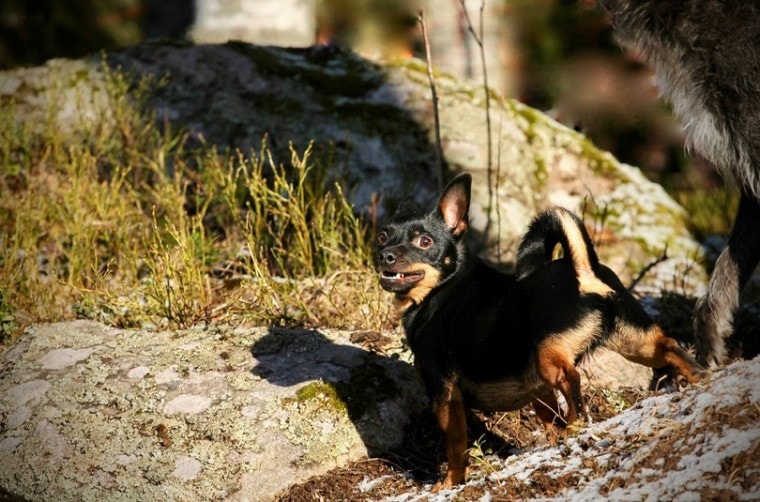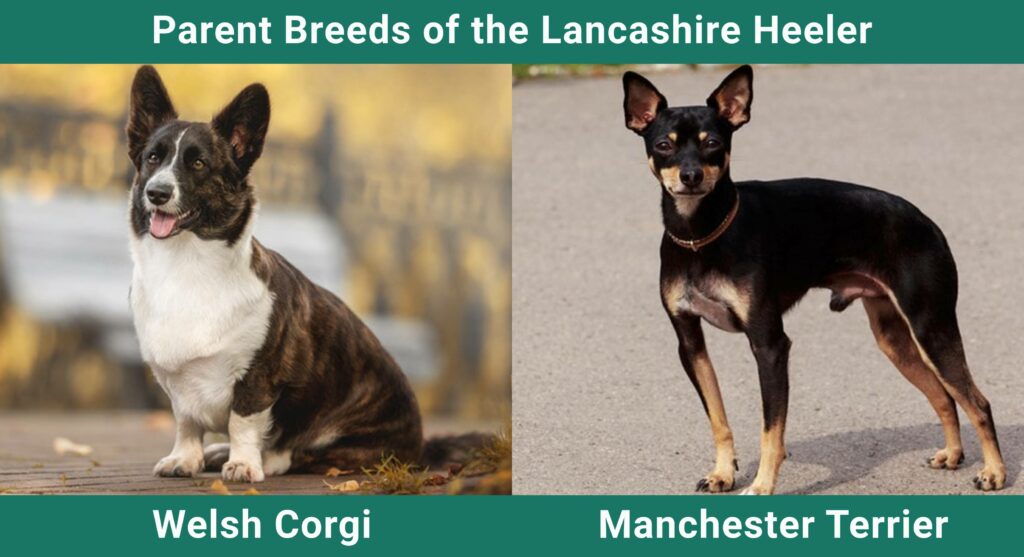
Click Below to Skip Ahead
This small, mighty dog breed was once used to drive herds of livestock to market and hunt rodents and pests around the farm. Hailing from England, the Lancashire Heeler is now a popular companion dog. This breed is thought to be the result of a cross between the Welsh Corgi and the Manchester Terrier, which explains its predisposition to both hunting and herding.
Breed Overview
Height:
10 to 12 inches
Weight:
13 to 15 pounds
Lifespan:
9 to 14 years
Colors:
Black or liver-colored with tan markings
Suitable for:
Active owners, apartment living, cold and hot climates
Temperament:
Affectionate, high-energy, playful
This purebred dog closely resembles its cousin, the Corgi, and holds a reputation for being mischievous, stubborn, and intelligent, traits held by most herding dog breeds. While their intelligence can make them easy to train, this dog has been bred to work. Without adequate exercise and mental stimulation, Lancashire Heelers will find other ways to expend their energy and can become quite destructive.
With proper care, the Lancashire Heeler is affectionate and loyal towards its owners. They are happy, alert, and always willing to go for walks. They make great family dogs and are generally safe with kids if adequately socialized as a puppy. They’re not always friendly to strangers, however, and can become quite anxious in crowded environments.
Lancashire Heeler Characteristics
Lancashire Heeler Puppies
Lancashire Heelers are bred to work. While they’re small in stature, they’re not exactly equipped to be lap dogs. Most of them would much rather go for a hike or run through an agility course than lounge around the house. Their hunting instincts, on the other hand, will keep your home mouse and rat-free.
The intelligence of this breed lends to easy training. This can work to your advantage about house training and general obedience. It also makes them great dogs for advanced trick training, agility, or other competitive events. On the other hand, these dogs are very independent and easily train themselves to exhibit negative behaviors. Once they have gotten away with something (like chewing your shoes, for example), they assume it’s alright and will do it again. For this reason, puppies require supervision and will benefit from kennel training to avoid getting themselves into trouble.
This dog breed is considered endangered by the UK Kennel Club. Because of their small genetic pool, there is an increased chance of genetic abnormalities in litters. Make sure to obtain your puppy from a reputable breeder who conducts health checks and genetic testing on their dogs.

Temperament & Intelligence of the Lancashire Heeler
Are These Dogs Good for Families? 👪
The Lancashire Heeler is an incredibly loyal dog, which implies that they are good pets for families. They most certainly are, but this qualification comes with a few caveats.
Lancashire Heelers are a herding breed, which means they will be more than willing to “herd” unruly children. Since they have been bred to nip at cow’s heels, they will do this to children as well if they feel they need to be rounded up. It’s important to train this behavior out of heelers while they are still puppies.
Puppies should always be well-socialized and trained. Lancashire Heelers who aren’t exposed to different people and dogs when they are young can become anxious as adults. While anxiety often results in retreating or standoffish behavior around strangers, it can lead to fear and aggression at the extreme.
Heelers can make fantastic, playful, loyal family dogs but should be treated with respect by young children like any other animal. There is always the potential for a dog to react sharply if they perceive a threat, so supervision is an absolute must for young children and pets.
Does This Breed Get Along with Other Pets?
While Lancashire Heelers are known for being affectionate with their owners, they can be less so with other dogs and strange animals. That said, if they are properly introduced to other dogs, they can learn to cohabit with them.
When it comes to small animals like cats, rabbits, or rodents, it’s safer if they don’t live with Lancashire Heelers. In addition to their herding instincts, these dogs are also hunters. Rodents and rabbits are fair game for hunting. They don’t consider cats prey, per se, but dogs with a strong prey drive tend to chase any animal that runs.
Things to Know When Owning a Lancashire Heeler:
Food & Diet Requirements 🦴
Lancashire Heelers are small dogs who are prone to packing on excess weight if you’re not careful. A diet containing protein and healthy fats, ground bone, and vegetables will provide them the vitamins and minerals required for them to thrive.
Quality dry dog food can be mixed with canned food, water, or broth to add variety to a Heeler’s diet, whereas people’s food should be kept to a minimum.
Exercise 🐕
As Heelers are energetic dogs, they are also highly intelligent, so they require at least 30-60 minutes of daily exercise and mental stimulation to stay healthy and happy. Mental stimulation, like training, will tire these dogs out faster than exercise will. As working dogs, they won’t volunteer to take a rest.
Walking, running, and biking are all great activities to do with these dogs, and they will also benefit from regular training sessions, puzzle toys, or games like fetch or hide and seek.
Training 🎾
The intelligence of this breed makes them willing and eager to please, but they can also be stubborn, making training challenging for first-time dog owners.
Because of their instincts, Lancashire Heelers should begin when they’re very young. They will need consistency and firmness throughout their life and know that you are their leader.
A lack of socialization or proper training for these dogs can cause them to display a dominant personality. Even though they’re small, dominance is hard to un-train. It’s much easier to be a strong leader from the beginning.
Grooming ✂️
Like many herding breeds, Lancashire Heelers have a double coat consisting of a fine-haired undercoat and a heavy, weather-resistant topcoat. They are short-haired dogs with slightly longer hair around their neck.
The coat is low-maintenance and only requires regular brushing. Lancashire Heelers should only be bathed when necessary, as excessive bathing can cause fungal infections on their skin. To prevent this, it’s important to make sure their undercoat is fully dried after a bath.
Double coated dogs are very adept at maintaining their temperature in any type of weather conditions and shouldn’t be shaved as it damages the health of their coat.
The short coat of the Lancashire Heeler does shed regularly, so you can expect to do some cleanup.
Health and Conditions 🏥
Male vs. Female
Assuming there’s no intent to breed, there are very few differences between male and female Lancashire Terriers once they have been spayed/neutered.
Some owners report that males are more laid back than females, but this seems to depend on the individual animal’s personality.
Males are slightly larger than females, topping out at an average height of 12 inches (30 cm), whereas females are about 10 inches (25 cm). Both males and females weigh between 9-13 pounds.
3 Little-Known Facts About the Lancashire Heeler
1. The Lancashire Heeler is an endangered dog breed.
This herding breed is extremely rare. There are so few of them that the UK Kennel Club declared them an endangered breed in 2003. Their status means that the genetic pool for purebred dogs is shrinking, increasing their risk of inherited diseases.
2. They “smile” to show they’re friendly.
The Lancashire Heeler is famous for a facial expression commonly known as the “heeler smile.” When these dogs are happy, they draw back their lips, exhibiting an unmistakable smile or smirk. The smile indicates that they are amicable, friendly, and content.
3. They’ve earned a nickname as the “nip and duck dog.”
As the smallest herding dog in the world, this all-purpose farm dog has strong instincts for cattle heeling, a herding technique where they nip at a cow’s heels and duck out. This behavior has earned them a nickname: “the nip and duck dog.”
Summary
Lancashire Heelers are fun, loving, and loyal dogs. While they are high-energy dogs, they’re very adaptable and can make themselves at home in a city apartment or a farmhouse. They do require proper socialization and training as puppies to maintain their friendly nature towards others. These dogs do best in dog-only homes as they have high-prey drives and are natural hunters, making them dangerous for other small animals. While extra care should be taken with small children, these dogs make a great addition to the family.
Featured Image Credit: LNbjors, Shutterstock









